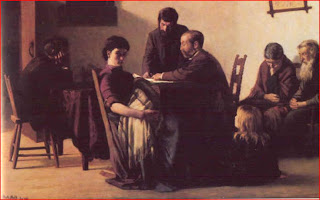 Mortgaging the Homestead
Mortgaging the Homestead"In 1890, George Reid was thirty. He had returned to Toronto after a year in Paris and had immediately begun work on a large and ambitious canvas, Mortgaging the Homestead. He submitted the picture as his diploma work for the Royal Canadian Academy, to which he was elected as a full member in 1891. Reid's painting, recounting a country family's misfortune, struck a powerful chord in a society which was so dependent on the land. It was a subject Reid could invest with the conviction of personal experience. Born and brought up on a farm in western Ontario, he had had to overcome considerable resistance from his father to pursue his artistic interests. At one point, the family was forced to mortgage the farm. To such people, a mortgage was a last resort, a serious blow not only because it meant yielding independence and control of one's destiny, but also because it carried the shame and stigma of failure.
"Ironically, what had been a low point in his family fortunes marked for Reid a major success in his career. Three years later, he painted in an even larger format a sequel, Foreclosure of the Mortgage. Widely exhibited across North America, this picture brought Reid highly favourable notices. (Regrettably, the painting was destroyed by fire in England in 1918. In 1935, Reid painted a second--and, one assumes, inferior--version from his original sketches, and this is now in the Government of Ontario collection.)
" Mortgaging the Homestead was typical for its time because of its choice of theme and its narrative presentation. In the emphasis Reid put on the painting of light he also showed himself responsive to the latest academic interests in Paris. The Salon of 1888, the year Reid went to Paris, was particularly noted for the emphasis that painters were giving to light effects. Yet unlike other Canadian artists who had gone to Paris (in particular William Brymner, Paul Peel, and Robert Harris), Reid did not fully adopt the French mode. Nor did his work indulge in the cloying sentamentality and heaping detail that characterized so much European painting of the time. His painting is spare in incident, concentrating on the strength of the characterization that he could bring to his figures.
"The origins of Reid's approach owes most to the years he had spent in Philadelphia studying with Thomas Eakins, one of the finest figure painters of the day. Reid took up Eakins' robust naturalism and his concern with describing individuals rather than types. Eakins looked directly to the people and circumstances of his time and place, an attitude that also marks Reid's best work.
"Reid invested a major commitment to the development of art in Canada through a long career as both painter and educator. When J. E .H. MacDonald wrote in the mid-1920s about the origins of an identifiably Canadian school of painting, he pointed to Reid as one of the most significant arists in its development. Reid taught from 1890 at the Central Ontario School of Art and Design, and he was president of the Ontario College of Art from 1912 to 1928. He became a great advocate of "public art" and undertook major decorative murals on historical themes at Toronto City Hall (1897-99) and the Royal Ontario Museum (1935-38). An extensive program of murals on historical themes at Queen's Park was not realized, but some of the subjects were later executed in murals at Jarvis Collegiate Institute in Toronto (1928-30). In 1944, shortly before his death, he donated to Ontario 459 paintings and works on paper, most of them for display and exhibition in schools across the province. Less than half the works are traceable today."
Source: From the history of Jarvis Collegiate.Toronto Board of Education, secondary school website. Please click here.
Isn't it shocking that more than half the works he left to Ontario can be found today? I wonder how many were just thrown away or disappeared into some attic? Very sad.
ReplyDelete